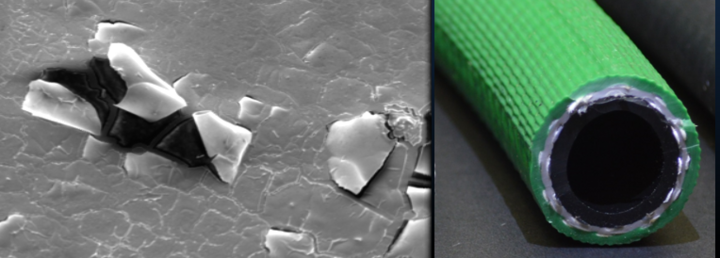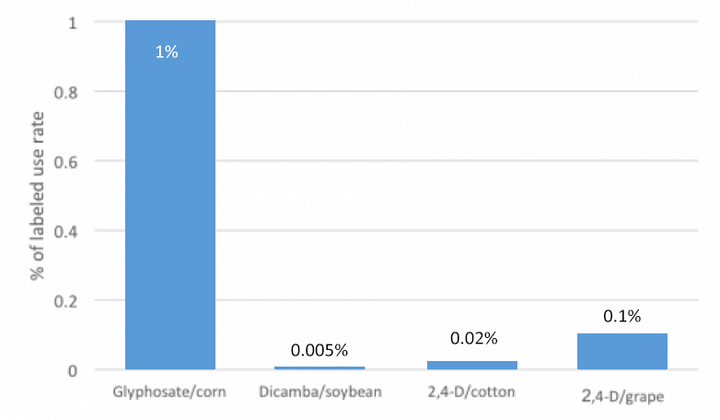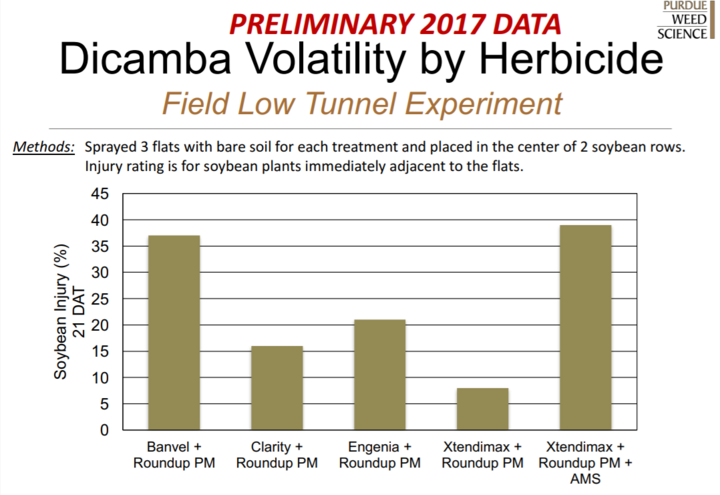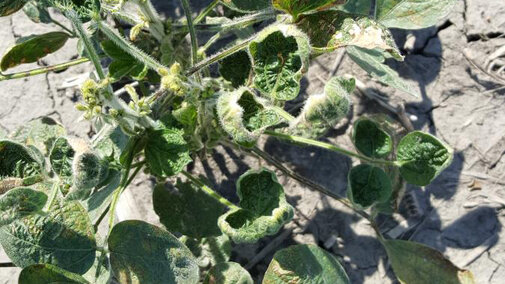In 2017, Nebraska Extension educators compiled a total of 348 complaints representing approximately 50,000 acres of dicamba injury to non-Xtend soybeans. Not all Extension educators chose to contribute to these reports. Nebraska Department of Agriculture received 90 complaints of dicamba injury to non-Xtend soybeans.
The EPA labeling for XtendiMax®, FeXapan®, and Engenia® herbicides expires on November 8, 2018, unless the U.S. EPA determines before that date that off-target incidents are occurring at unacceptable frequencies or levels.
In a survey of 312 farmers from 60 Nebraska counties representing 192,301 acres, 93% had better weed management in dicamba-resistant soybean. With those positive results, can we manage the application of dicamba to acceptable levels so we are able to continue to use dicamba in soybean? One take-home message from the survey was that planting of Xtend soybeans is expected to increase significantly in 2018. This may reduce dicamba injury to soybean; however, off-target movement to other broadleaf crops and ornamental trees may be of concern because of more dicamba-based herbicide applications. Reducing off-target pesticide movement is critical in 2018.
Off-target movement of dicamba can occur due to number of factors: physical particle drift, tank contamination, and volatility or vapor drift.
Related Stories
- Removing Dicamba Residues from Your Sprayer: A Tricky Task
- Potential Off-Target Dicamba Movement from Corn Applications

Physical Particle Drift
Applicators need to manage physical particle drift for on-target pesticide applications. It can be managed significantly by
- spraying when wind speeds are 3 to 10 mph at boom height,
- keeping boom height low at 24 inches from the target,
- implementing a downwind buffer (i.e., coming back and finishing a field later near sensitive crops and sites),
- and using approved extremely coarse or ultra-coarse spray nozzles and operating them at the proper pressure range.
Tank Contamination
Please see Removing Dicamba Residues from Your Sprayer: A Tricky Task for more details.
Volatility or Vapor Drift
| Trial | Exposure (Hrs after app) 0-24 | Exposure (Hrs after app) 24-48 | Exposure (Hrs after app) 48-72 |
|---|---|---|---|
| % Soybean Injury | |||
| 1 | 64 | 50 | 25 |
| 2 | 56 | 6 | 0 |
| 3 | 64 | 0 | 4 |
| 4 | 78 | 62 | 31 |
| 5 | 60 | 50 | 48 |
| Dicamba-Treated Surface | Soybean Injury Index RatingsA |
|---|---|
| Soybean leaves | 40 |
| Corn leaves | 39 |
| Soil (silt loam) | 26 |
| Glass | 15 |
| Velvetleaf leaves | 2 |
| Blotter paper | 0 |
| Check (no dicamba) | 0 |
| Bayes LSD 0.05 | 11 |

| Simulated rainfalla (in) | Soybean injury index ratingsb |
|---|---|
| 0 | 36 |
| 0.04 | 5 |
| 0.08 | 3 |
| 0.16 | 5 |
| 0.31 | 3 |
| 0.63 | 1 |
| Check (no dicamba) | 0 |
| Bayes LSD 0.05 | 5 |
BSoybean injury index ratings: 0 = no effect, 100 = complete kill
Source: Behrens, R. and W.E. Lueschen. 1979. Dicamba volatility.
Weed Science Journal 27:486-493.
| Temperature | |||||
|---|---|---|---|---|---|
| 59 | 68 | 77 | 86 | 95 | 104 |
| % soybean injury | |||||
| 3 | 15 | 32 | 40 | 32 | 35 |
Source: Behrens, R. and W.E. Lueschen. 1979. Dicamba volatility. Weed Science Journal 27:486-493.

Vapor drift can occur with dicamba when it changes from a liquid state to a gas state which can move off target. The highest amount of volatility is in the first 24 hours after application, but it has been measured as long as four days after application. Results of Behrens, et. al, 1979, research for three days is shown in Table 1. In this research, dicamba was applied to corn and five different trials looked at percent soybean injury from 0-72 hours post-application. The large reduction in percent soybean injury observed in two of the trials between 24 and 48 hours are situations when rain events of 0.12" and 0.35" occurred 12 and 14 hours after the dicamba application to corn.
Some of the factors affecting volatility of dicamba include temperature inversion, application rate, plant leaf area surface (Table 2 shows substantial dicamba volatilization from corn and soybean leaf surface), humidity, temperature, whether AMS or UAN is tank-mixed, hours of exposure to a sensitive crop, rainfall or irrigation, little to no wind, type of glyphosate salt used, tank mix partners, and adjuvants and type of dicamba formulation.
The new dicamba herbicides for soybeans and cotton have lower volatility (50-70%) compared with Clarity based on research presented at the 2017 North Central Weed Science Society Annual Meeting. This, along with the October 13, 2017 label changes on XtendiMax®, FeXapan®, and Engenia®, should reduce problems in 2018 from these herbicides to non-Xtend soybeans and other vegetation susceptible to dicamba. But, as noted above, with the expected use of dicamba to increase significantly in 2018, we need to be careful and follow label requirements in 2018.
Non-Xtend soybeans are 200 times more susceptible to dicamba at the standard use rate to visible injury than non-Roundup Ready corn is to glyphosate at the standard use rate (Figure 1). Even with those much lower levels, we had lots of injury to non-Roundup Ready corn when Roundup Ready soybeans were first available in 1996 and the soybeans were sprayed with Roundup (glyphosate). Soybeans are so susceptible to injury from dicamba that in a 1971 bulletin, Ellery Knake, extension weed specialist at the University of Illinois, discouraged the use of dicamba in Illinois due to the sensitivity of soybeans to dicamba.
Best Management Practices for All Dicamba Applications
Time Irrigation for Product Efficacy
As little as 0.04 inches of rainfall (Table 3) or 1000 gallons per acre of irrigation can decrease dicamba volatility. Irrigation is not prohibited on the older dicamba labels (i.e., Clarity) once the rainfast period (four hours after application) is met. Delaying irrigation for at least eight hours allows for increased dicamba efficacy. In general, an irrigation or rainfall event may help reduce volatility potential of dicamba; however, due to label restrictions, Xtend soybean fields cannot be irrigated up to 24 hours after application of XtendiMax®, FeXapan®, and Engenia®. Corn fields can be irrigated eight hours after dicamba-based corn herbicides (except for the three RUP dicamba products) if volatility is a concern. Irrigation may be beneficial if the forecast is for wind direction to change toward susceptible crops or vegetation. Do not allow any irrigation runoff for off-target issues.
Avoid Using AMS with Dicamba Applications
The high temperatures and low humidity that occurred last year when many acres of corn were sprayed may have been part of the problem with dicamba injury (Table 4). Applicators caught in the same environmental conditions in 2018 with corn dicamba applications need to realize AMS will increase dicamba volatility regardless of salt formulation applied. This is why use of AMS with the RUP dicamba formulations is prohibited as addition of AMS increased soybean injury via volatility (Figure 2). For this reason, consider not using AMS with any dicamba applications. Use the best quality water as possible so minerals do not antagonize with dicamba/glyphosate efficacy to any significant degree. One producer in west central Nebraska is reportedly using reverse osmosis to soften water being used for herbicide applications. Dipotassium phosphate adjuvants listed as one of the new dicamba tank mix partners can be used.
On some plant species, AMS increases glyphosate efficacy even when the spray solution is prepared in distilled water (where no calcium or iron is present), notes former Nebraska Extension weed scientist Mark Bernards in a 2007 Nebraska Extension Crop Production Clinic article. Velvetleaf is a good example of this phenomenon. On velvetleaf, adding AMS increases the amount of glyphosate that is absorbed by the plant, and/or the amount of glyphosate that moves from the treated leaf to the growing point or roots where it acts to kill the plant. AMS prevents glyphosate from binding to calcium or dirt on the surface of the leaf, and the NH4+-glyphosate complex may pass through the waxy layer on the leaf surface better than glyphosate alone.
In research studies, AMS has been shown to have either a positive or neutral effect (common lambsquarters) on glyphosate efficacy, absorption, and translocation. Consequently, when it is added at the recommended rates (8.5-17 lbs/100 gal), it will, in most cases, increase glyphosate activity, and should never (or only very rarely) reduce glyphosate activity.
Growers may consider increasing the glyphosate rate to compensate for not including AMS, but applications should not exceed labeled rates for glyphosate.
Avoid Dicamba Use in Both Corn and Soybean
Because of widespread occurrence of glyphosate-resistant weeds in Nebraska in recent years, the use of dicamba (Clarity, DiFlexx) or products containing dicamba (Status, DiFlexx DUO) has greatly increased in corn. Herbicide programs should be planned and implemented in a way that dicamba is not used in corn and Xtend soybean successively because repeated use of dicamba will increase selection pressure and may result in the evolution of dicamba-resistant weed(s).
Consider Using the More Restrictive RUP Dicamba Guidelines for All Dicamba Applications
Applicators need to manage all dicamba applications in Nebraska in 2018. It starts by improving our dicamba application methods in corn and other crops and reading and following all label guidelines with the new RUP dicamba formulations. For all corn, soybean, and other dicamba applications, the revised XtendiMax, FeXapan, and Engenia labels provide great information which will help in reducing off-target injury issues. The information in the new labels can also increase efficacy from dicamba with more of the herbicide being deposited on target. The information includes:
- Scout area for susceptible crops and vegetation
- Buffer zone requirement
- Boom height (no greater than 24 inches)
- Nozzle selection and pressure
- Spray volume
- Wind speed (3-10 mph) and direction
- Times of application (sunup to sundown)
- Problems with tank mixing products containing ammonium salts such as ammonium sulfate and urea ammonium nitrate
- Sprayer travel speed (no greater than 15 mph)
- Tank cleaning
Take Home Message
Consider each dicamba product as a restricted use pesticide, follow label requirements, and avoid using AMS with any dicamba-based herbicide.
References
Behrens, R. and W.E. Lueschen. 1979. Dicamba volatility. Weed Science 27:486-493.
Bernards, Mark L. 2007. AMS - What is it Doing in my Tank? 2007 Crop Protection Clinics Proceedings, 123-126.
Bradley, Kevin. 2017. Off-target Movement of Dicamba in Missouri: Where Do We Go from Here?
Hartzler, Bob. 2017. Dicamba: Past, Present, and Future.
Mueller, Thomas C., Daniel R. Wright, and Kirk M. Remund. 2013. Effect of Formulation and Application Time of Day on Detecting Dicamba in the Air under Field Conditions. Weed Science 61:586-593.

